What varieties of cucumbers are there, complete classification
Cucumbers are grown in gardens, in greenhouses, and on windowsills at home. The right choice of variety is a guarantee of a rich harvest. By properly alternating crops, you can get fresh cucumbers all year round by planting them in open and closed ground.
From the article you will learn by what criteria cucumbers are classified, which variety to choose for a greenhouse, balcony, or vegetable garden, what types of pollination there are, and what to consider when choosing seeds.
Botanical description of the common cucumber
The tropical and subtropical forests of India are considered the homeland of the cucumber.
Cucumber (Cucumis) is an annual vegetable crop that belongs to the pumpkin family. It has a long creeping stem up to 2 m. At the ends of the stem there are tendrils with which the plant is attached to the support. The leaves are five-lobed, heart-shaped.
The fruits are green in different shades depending on the variety. The sizes and shapes are also varied: smooth, pimply, long, short. The fruit is polyspermous.
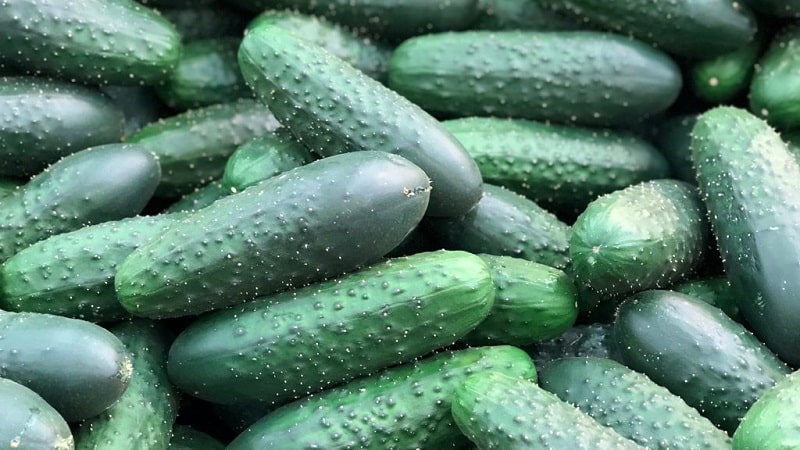
Classification of cucumber varieties
Beginning gardeners often get lost in the variety of varieties and types of crops. Let's talk about them in detail.
By purpose
According to their purpose, cucumbers are divided into three groups.
Universal
Universal varieties are grown in greenhouses and open ground. Used for salads or salted. The peel of the fruit is not dense - the salt easily penetrates deep into it. The average length is from 8 to 11 cm. Disadvantage: when pickled, the fruits are not crisp enough. The color of the spikes is black.
Universal varieties and hybrids:
- Nord Stream F1 – early ripening, produces a bountiful harvest, pollinates independently. Forms a bouquet-type ovary. Can grow in difficult climatic conditions. The fruits are bright green, covered with small tubercles. They grow up to 12 cm and weigh 50 g.
- Diva – an early ripening variety of female type of flowering. The plant is vigorous, with large green leaves and highly developed vines. Grown only in a greenhouse. The harvest is produced 35 days after planting. Bundle-shaped ovaries, 3-4 pcs. The fruits taper at the top, up to 12 cm long, cylindrical in shape. Weight – 110 g. Cucumbers with white spines, slightly lumpy. Gives a bountiful harvest (up to 28 kg per 1 m²). Suitable for canning and salads.
Salting
Pickling varieties or hybrids are used for canning, pickling, and pickling. They have thin skin and elastic flesh. The fruits are lumpy, with black spines, up to 8 cm in size.
Examples of hybrids:
- Sigurd F1 – early ripening with high yield. It is resistant to temperature changes and does not shed ovaries in the heat. The fruits grow up to 12 cm, covered with large tubercles. The hybrid is disease resistant. Fruit weight 70-90 g.
- Magdalena F1 – parthenocarpic early hybrid. Used for growing pickles and gherkins. The plant is vigorous with unlimited stem growth. Side shoots grow moderately. Fruits are formed in one node (3 pieces). Grows under film and in beds.
Salad
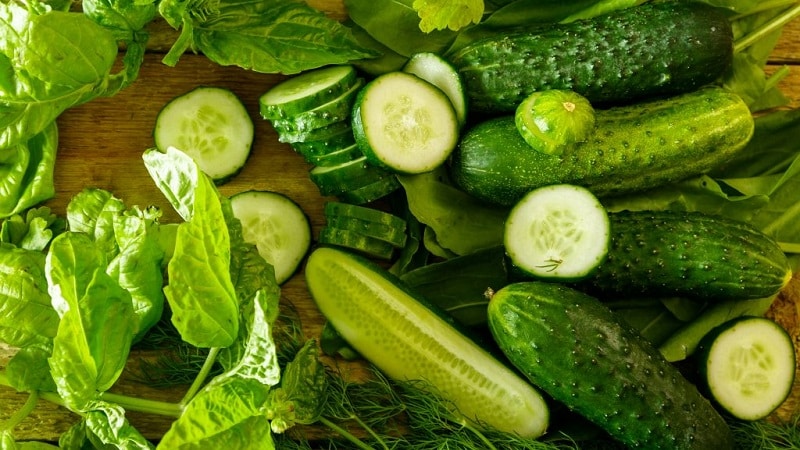
Smooth salad varieties of cucumbers are grown in greenhouses or under film. This early, productive varieties – White angel, Athlete, Makar, Orlik.
The fruits are elongated, up to 20 cm long, with a thick skin and covered with white spines. The juicy, loose pulp does not have a strong, pronounced taste. Not suitable for canning.Salads are prepared from them and consumed fresh.
According to bush height
The choice of variety depends on the place where the crop is grown - whether it will be a spacious bed in open ground or cramped conditions on a balcony. Varieties vary in bush height.
short
Low-growing - bush varieties. They are easy to identify by their names: Baby, Baby, Shorty, Bush.
The length of the stem in open ground reaches 50 cm, in a greenhouse – up to 1 m. The plant is of a determinate type and has many ovaries. Small fruits are formed mainly on the main stem, the side shoots are poorly developed. Fruiting occurs quickly, the entire crop ripens in 20 days. The fruit is black pubescent, sparsely tuberculate, grows up to 7 cm.
Medium height
Medium-sized cucumbers are grown on the balcony, in a greenhouse, or in the garden.
Vector is a mid-season variety, has small vines (up to 1.5 m). The fruits grow up to 12 cm and have white spines. Pollinated by bees. In Eastern and Western Siberia gives a yield of up to 2.3 kg/m². Suitable for preservation.
Tall
Tall varieties are grown in gardens, in greenhouses. They are fixed on a trellis. The length of the tops reaches 3 m.
Hybrid Chinese farm F1 – tall (up to 3.5 m), medium early, formed into one stem. Needs tying to a trellis. The fruits grow up to 90 cm, cylindrical in shape. The skin is thin, the flesh is juicy and elastic. Can be grown in beds, in greenhouses and under film. Resistant to diseases and pests.
Determinate varieties of cucumbers
These include low-growing varieties with a stem length of up to 50 cm. High-yielding varieties, the fruits ripen at the same time - Vyazemsky 37, Hector f1. They are grown in greenhouses, greenhouses, and open ground. The main stem grows upward until the flower bud appears.Then side shoots grow, on which fruits are formed.
To increase the yield on the fifth leaf, pinch the top of the main stem. This stimulates the regrowth of side shoots. New shoots are pinched on the eighth leaf.
Important! Barren flowers on the main stem are removed.
Indeterminate varieties of cucumbers
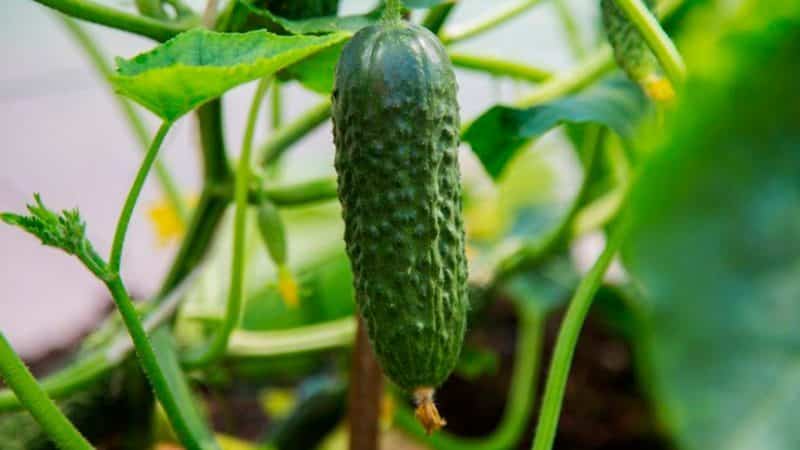
These are hybrids intended for growing in greenhouses. The bush grows more than 2 m. In good light, the central stem is not pinched; ovaries form on it. Plants are tied to a trellis. Examples – Siberian Garland f1, Emerald City f1, Courage f1.
Important! It is impossible to grow determinate and indeterminate varieties in the same greenhouse - this leads to bitterness of the fruit.
By place of cultivation
Varieties that are resistant to cold weather, heat, rainy weather, and drought are planted in open ground:
- Serpentine – early ripening variety. The first fruits appear in June. They have an ovoid, elongated shape, light green color, covered with tubercles with black fluff. Length up to 10 cm. Fruits weighing up to 95 g, gherkins, do not taste bitter, ideal for preservation.
- Christina – an early-ripening popular high-yielding variety. Harvest – 10 kg/m². Can grow in closed and open ground. The bushes are medium-branched, with 2-3 fruits from each ovary. The leaves are dark green. The length of the fruit is 8-10 cm, weight - up to 90 g. The greens are cylindrical in shape, without bitterness. The peel is covered with white spines.
- Monisia F1 – for open ground, bee-pollinated hybrid with female flowering type. Male inflorescences rarely appear. Productivity per hundred square meters is up to 22 kg. The bush grows up to 2 m, the leaves are tuberculate, rough, dark green. The fruits are cylindrical in shape, covered with white, barely noticeable stripes and fluff. The fruit grows up to 8 cm, weighs 75 g. A hybrid for universal use.
- Grandma's secret – an early ripening hybrid, bears fruit on 45-50 days, parthenocarpic. The fruit is dark green, not bitter, covered with white fluff, has a cylindrical shape, large tubercles. Weight 80-90 g. Zelentsy is salted and consumed fresh.
- Barvina - an early ripening hybrid, medium-sized with weak branching. Grown in open ground and greenhouses. Does not require pollination by bees. The growth of the central stem is not limited, it has a female type of flowering (1-2 ovaries in the leaf axil).
Parthenocarpic-type varieties are grown in greenhouses (self-pollinating cucumbers capable of forming fruits without the participation of insects). The fruits of these varieties do not have seeds.
Examples of hybrids:
- Kate f1 – parthenocarpic, grown in Russia, Ukraine, Moldova in the winter-spring period. Early ripening, fruits are smooth, medium-sized, elongated. Grows up to 120 g.
- Caroline f1 – suitable for greenhouses and under film shelters, parthenocarpic, universal purpose. Begins to bear fruit on the 44th day. The inflorescences are female and produce few branches. The fruits are medium-lumpy, short, dark green in color, with white fluff. The leaves are small in size. Fruit weight – 95 g. Harvest per 1 m² – up to 13 kg. The hybrid is disease resistant.
- Cucumber Madrilene f1 - grown indoors. In warm weather, according to reviews and descriptions from gardeners, the Madrilene f1 cucumber is planted in the beds. The plant is tall (up to 3 m), tied to a trellis. The bush is formed with one stem, the side shoots are removed. Early ripening hybrid, gherkin. The fruits are large-tubercular, dense, 9-12 cm long, weighing up to 100 g.
- Excelsior f1 – for salad purposes, grown in greenhouses in winter. The fruits appear on the 50th day. The plant produces only female flowers.Each node contains up to three flowers. The fruits are large (up to 120 g). The Excelsior f1 cucumber is distinguished by its high yield (from 1 m² to 13-14 kg) and resistance to disease.
- Zozulya F1 - a popular hybrid, mainly with female flowers, does not require pollination. Harvest – up to 8-16 kg per m². The culture is bred for growing on a windowsill or in a greenhouse. Early fruiting (45-50 days).
Insulated and glazed balconies facing south or southeast can be used as a small area for growing fresh vegetables.
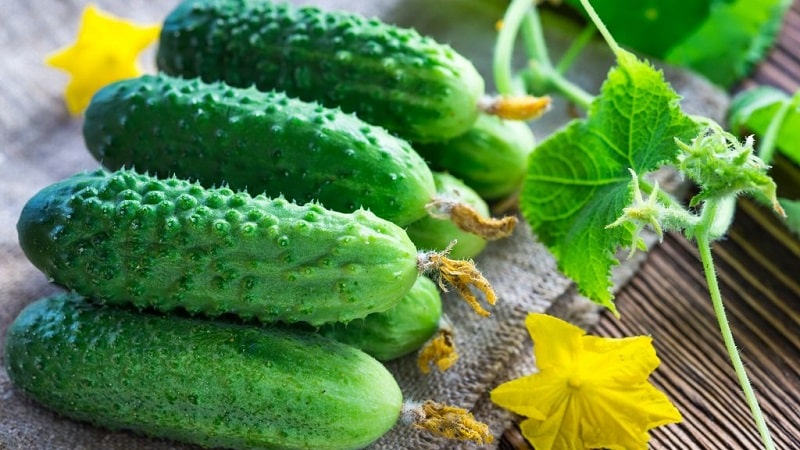
Suitable hybrids: City cucumber, Balcony, Balagan, Berendey, Courage, Manul, Calendar, Hummingbird, Machaon. These are early ripening, gherkin, beam hybrids. They have weak branching and short side shoots. There are up to 6 ovaries in the nodes. The greens are tuberculate, oval in shape, with light stripes, up to 10 cm long. Parthenocarpic hybrids of the female type, resistant to diseases and lack of light and moisture. They have long, branching stems with short internodes.
In winter, cucumbers specially bred for cultivation on the windowsill are grown on windows facing south or east. Medium-branched, self-pollinating hybrids with high yields are used.
For early sowing in February, choose varieties that bear fruit in short daylight conditions: Forward, Faust.
In the second part of February, plants with the female type of flowering are planted: Relay Race, Olympics, Manul, Marathon. Pollinated by hand.
In early March, parthenocarpic early ripening hybrids are planted: Arbat, Flagman, Galina, Elizaveta, Patti, Primadonna, Atlet. The fruits can be canned. The bushes have shoots of medium length.
According to ripening time
Selecting varieties based on ripening time will help you get a harvest all year round.
According to the growing season, varieties are distinguished:
- early;
- mid-early;
- late.
Early varieties begin to bear fruit at 32-40 days.
Early ripening varieties and hybrids:
- Alekseich f1 – early ripening, with high yield. The plant is parthenocarpic. Zelentsy grow up to 7-8 cm, without bitterness. They have a cylindrical shape, with slightly pronounced tubercles. Fruit weight is 60-75 g. The vine is of medium height, the side shoots grow weakly. Inflorescences are of the female type, forming 2-3 fruits in one node. They are grown in beds under film, in greenhouses. The hybrid is resistant to diseases (powdery mildew, downy mildew). Suitable for pickling and salting at the stage of pickles and gherkins, for salads. Productivity up to 13-14 kg per m².
- Harlequin – an early-ripening hybrid is grown in open areas and under film. The stems are medium-sized (up to 1 m), the fruits grow in bunches of 2-3 pieces. Self-pollinating, female flowering. Zelentsy with white spines and smooth tubercles grow up to 16 cm and weigh 100-130 g.
- Funny boys – an early ripening hybrid that produces a high yield. Grows in beds and greenhouses. The lashes grow up to 2.5 m. The plant has medium branching and needs to be tied up in a greenhouse. Flowering type: female. The fruits are short, tuberous, with white fluff, and cylindrical in shape.
Mid-season varieties of cucumbers begin to bear fruit on the 50th day from seed germination.
These hybrids include:
- Polan F1 – the fruiting period will be extended until late autumn. Polan f1 cucumbers are evenly shaped, bright green, up to 10 cm long. The hybrid is bee-pollinated, grown under film, in beds. Used for preservation.
- Excelsior F1 – a hybrid for growing in difficult weather conditions. It has a powerful root and two side shoots.There are 1-2 fruits per node: dark green, 12 cm long, cylindrical, with large tubercles.
- Tatyana F1 – mid-season hybrid for salads. The plant is indeterminate, has medium-length vines with a female type of flowering (up to 3 fruits per node). The fruits are green, with white fluff, cylindrical in shape, with a short neck visible at the base. The fruit is long-fruited, up to 18 cm, weighs 130-140 g. Resistant to powdery mildew.
Late varieties begin to bear fruit on the 50th day after germination. Examples: Phoenix, Athlete f1, Sunny, Crunch f1.
By type of pollination
Cucumbers that produce fruit without pollination are parthenocarpic. The fruits have no seeds.
Examples of hybrids: Dutch yellow cucumber, Alliance, Alena, Alice, Brawler, Babylon, Valentina, Cornflower, Villina, Media, F1 Nastenka, F1 Prometheus, F1 Talisman, F1 Tatyana.
How to choose the right cucumber variety
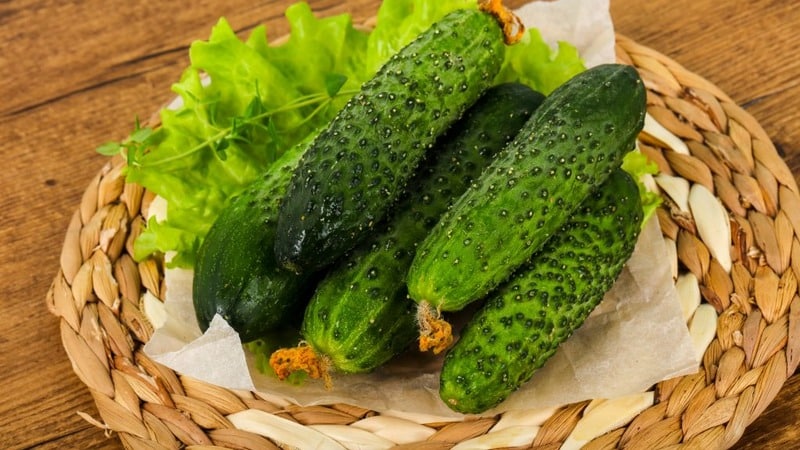
When choosing a cucumber variety, they are guided by the following criteria:
- landing place;
- ripening time;
- type of use of the crop.
Basic rules for growing cucumbers
All cucumbers need care:
- plants are planted in fertilized and dug soil - humus, compost, rotted manure are used;
- watering - do not allow the soil to dry out, water in hot weather three times a week;
- loosen the soil between the rows;
- mulch the soil in the rows and between them;
- Fertilize every two weeks - nitrogen fertilizers are applied at the beginning of the season, and phosphorus-potassium fertilizers are applied from the moment of fruiting.
Which varieties of fruits are the healthiest?
All varieties of cucumbers are good for the nervous system and stomach. They are rich in vitamins, strengthen the immune system, and slow down the aging of the body.
It is believed that the fruits of varieties grown in open ground are healthier than those grown in greenhouses, as they contain less nitrates.
Storage conditions for each variety of cucumbers
Not all varieties are stored equally. Pickling and universal ones have a longer shelf life. They can last up to two weeks in the cellar or refrigerator.
Salad cucumbers are stored in cool conditions for 5-7 days.
conclusions
The variety of cucumbers for planting is chosen depending on the purposes and growing conditions. Self-pollinating varieties are used for greenhouses, and bee-pollinated varieties for vegetable gardens. Fruits with black thorns are preserved.
In winter, early ripening hybrids are used to grow crops on window sills and loggias. To ensure continuous fruiting, cucumbers of different ripening periods are planted.